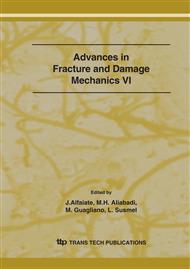p.257
p.261
p.265
p.269
p.273
p.277
p.281
p.285
p.289
Effect of Preformed Angle in Lap Zone on the Failure Procedure of Adhesively Bonded Aluminium Joint
Abstract:
The effect of the preformed deflection angle in the lap zone on the failure mode and the stresses distribution in the single-lap joint made of the epoxy adhesive and the aluminium adherend was investigated using elasto-plastic finite element method (FEM) and the experimental method of the shear strength testing. The failed surfaces were studied with the diagrams of scanning electron microscopy (SEM). The results from the numerical simulation showed that all the peak stresses in adhesively bonded single lap joint were decreased first and increased again as the preformed deflection angle was increased from 00 to 150. The lowest values occurred when the angle was taken as 100 and its strength is 22.1% higher than that of the standard one as the peak stresses were decreased and the stress distributed more evenly. The SEM images also show that the failure mode of the joint was transmitted from the adhesion to the mixed one as the deflection angle increased.
Info:
Periodical:
Pages:
273-276
Citation:
Online since:
September 2007
Authors:
Price:
Сopyright:
© 2007 Trans Tech Publications Ltd. All Rights Reserved
Share:
Citation:


